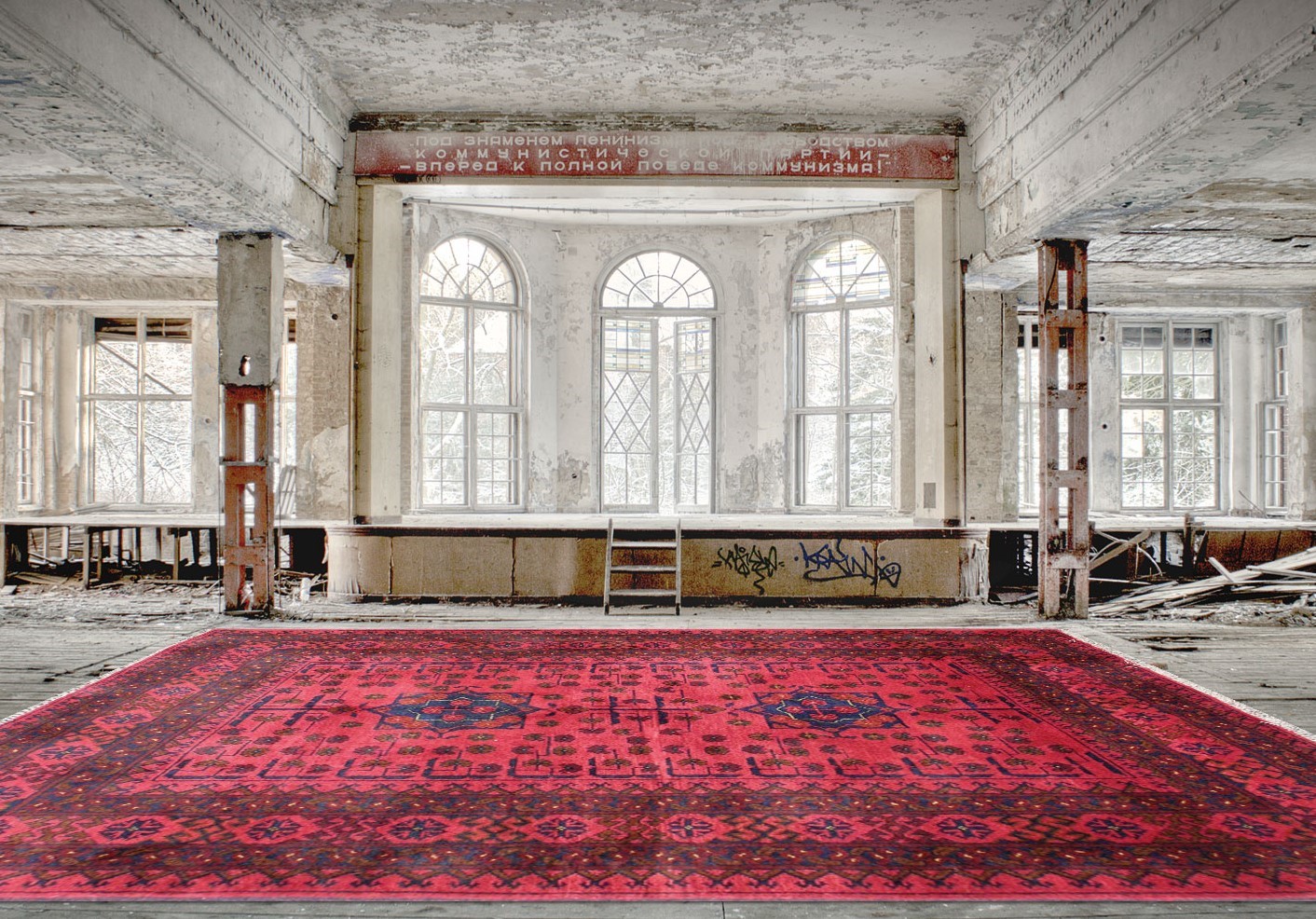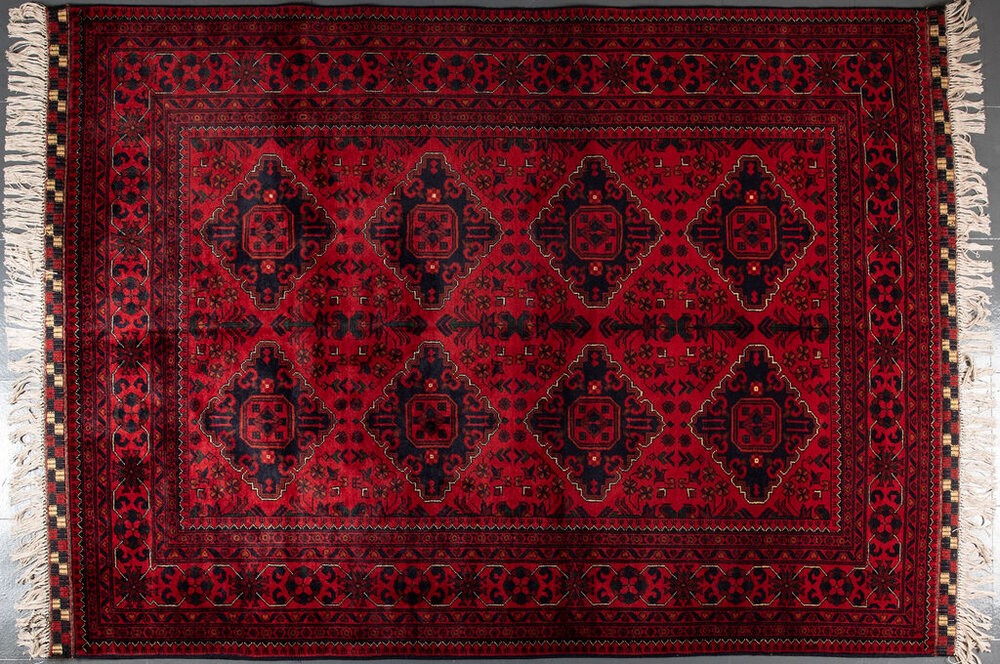Among Afghan carpets, Khal Mohammadi rugs are without a doubt one of the most beautiful.
These carpets distinguish themselves from the competition thanks to their attention to detail, timeless classic designs, and luxury texture. Their rich crimson colors with blue or black patterns give any living room a subtle touch of heritage and elegance.
Don't be hesitant to get a magnificent Khal Mohammadi rug if you're looking for a new rug to add a touch of elegance and class to your house.

Khal Mohammadi Rug – A Brief Introduction
Afghan carpets come in a wide range of regionally unique designs. Khal Mohammadi rugs, however, would be the ideal option if you want to showcase a genuine Afghan carpet to the globe.
A genuine Afghan-style rug, the Khal Mohammadi rug has all the characteristics of one.
Recent history places their origin in Afghanistan. Since they still follow the original patterns closely, the Turkmen weaving tribes in the Kunduz region continue to produce these carpets.
The weaving designs and methods used by these tribes are conventional. Afghan Khal Mohammadi rugs alone use these methods. Additionally, a few tribes of Afghan refugees in Pakistan take great pride in producing Khal Mohammadi rugs.
An exceptionally warm environment is made possible by a Khal Mohammadi rug. These Afghan carpets are among of the most well-known oriental rugs in the world.
History of Khal Mohammadi Rugs
The unique name of these carpets is the first thing you notice about them.
Khal Mohammadi rugs are called after their gorgeous artist, as opposed to other rugs, which obtain their names from the country of origin. These carpets' ancestry is not very old. Due to the Afghan-Soviet conflict in the late 1970s, a large number of Afghans left their country.
An Ersari Turkmen indigenous rug maker named Khal Mohammad made the decision to remain in Kunduz, his hometown in northern Afghanistan.
This famous Khal Mohammadi rug pattern was made possible by Khal Mohammad's weaving talents. It eventually turned into a representation of Afghan weaving culture.
In contrast to many other lines, they are named after a famous figure who not only developed the amazing designs we see today but was also well-known. This pattern is available in a variety of sizes and hues, including deep reds, maroons, and blues.
Wonderfully lucid descriptions, facts, and photographs; we're thrilled with the caliber.

Features of Khal Mohammadi Rugs
Rugs from the Khal Mohammadi region are known for their distinctive and unmatched colors and designs. These carpets have superb wool quality and amazing workmanship. The Khal Mohammadi carpets contain vibrant colors, distinctive designs, and a high knot density.
Let's examine these traits in further detail:
1. A Range of Weaving Methods
The greatest Afghan weaving methods, which have been used for many centuries in this area, are used to create Khal Mohammadi rugs.
The Khal Mohammadi Persian carpets are known for their magnificent warm tones, which are produced using natural vegetable dyes. Khal Mohammadi patterns are used in several Afghan rug designs. For instance, Kunduz and Beljik carpets have Khal Mohammadi motifs.
Buy Khal Mohammadi Rugs that are expensive have a higher knot density, making them more resilient, plush, and elegant.
2. The Use of Top-Notch Materials
The top-notch sheep wool is used in Khal Mohammadi rugs.
In Afghanistan's mountains, these sheep eat local fresh plants. They, therefore, supply the neighborhood carpet weavers with top-notch wool.
A long-lasting and durable Khal Mohammadi rug is made possible by the use of materials of the highest caliber. Family relics made from these carpets are simple to transmit to future generations. The low pile of the Khal Mohammadi rug also makes cleaning them simple.
3. Various Hues and Designs
The Khal Mohammadi rug has a red backdrop, although there are several tints and tones of red. Khal Mohammad was an expert dyer as well, and it was he who independently created the distinctive crimson hues of these Afghan carpets.
'gul' (flowers) and 'fil pai' (elephant's foot) in navy blue, orange, and beige are the reoccurring designs of Khal Mohammadi carpets. Despite being straightforward, these designs have a lovely appearance.
They also offer the ideal counterpoint to the vivid hues of Khal Mohammadi oriental rugs.
Standard sizes for Khal Mohammadi carpets include 3 x 5, 4 x 6, and 8 x 11, and they are available in a variety of designs, with tribal and abstract being the two most popular.
Although larger carpets can be found, Khal Mohammadi rugs typically range in size from small to medium.
They are said to be the designer's choice for home décor since they bring out the boldness of the interior's style and are utterly ideal in any location, particularly the modern house or workplace.
Are These Rugs Good Quality?
Afghan carpets are renowned for their unique patterns and vivid colors. Many people are unaware that Afghanistan has a variety of weaving areas and weaving techniques.
As a result, each of these areas has its own aesthetic.
Because of their exquisite quality and appealing design, Afghan handcrafted carpets are well known around the world. However, if you're still unsure about Khal Mohammadi carpets, browse through our portfolio and take in the stunning patterns and hues.
You'll want to purchase one right immediately!
At Qaleen, we provide a wide variety of Khal Mohammadi handmade rugs in both sizes and styles. You may pick from our exclusive assortment of Khal Mohammadi rugs, ranging in size from a tiny runner to a huge area rug.
Each of these patterns provides a style that is more appropriate for your house. But avoid wasting time on uncertainty.
Contact us instead so we can assist you in selecting the best carpeting for your needs. In every other case, choose the design that appeals to you the most. In either case, making a purchase of a high-quality Khal Mohammadi rug is worthwhile.
Every time you gaze upon it or step upon it, you will adore it.













